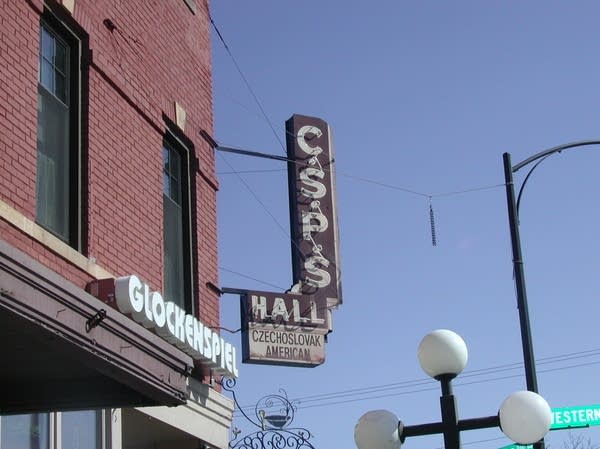Sokol keeps Czech-Slovak heritage alive
Go Deeper.
Create an account or log in to save stories.
Like this?
Thanks for liking this story! We have added it to a list of your favorite stories.

The Czech-Slovak Protective Society, or CSPS, started as an insurance agency of sorts -- a way for Czechs and Slovaks to pool their resources to help families after a death or disaster in the community.
But on the top floor of the CSPS Hall on Saint Paul's West Seventh Street, Joe Landsberger said the memories associated with the building are far from morbid or disastrous.

"I talk to these people and they say 'Oh, yeah, my parents would drag us all down for the dances. We'd fall asleep on the coats on the benches and they would dance and drink beer and have a good time'," said Landsberger. "It was a different thing that these days doesn't exist, because it was really community and it was really family oriented."
The CSPS Hall keeps a slice of that community alive, as it has for generations of Czechs and Slovaks who gathered here for dances, lectures, concerts and theatrical performances, which until the mid-twentieth century were conducted in Czech.
Turn Up Your Support
MPR News helps you turn down the noise and build shared understanding. Turn up your support for this public resource and keep trusted journalism accessible to all.
Today, the hall is rented by various groups for parties, weddings and other events. But it's home to an organization called the Czech-Slovak Sokol Minnesota. Sokol is the Czech word for falcon. The name was applied to a group that's rooted in Czech-Slovak heritage.
Members of Sokol Minnesota have gathered in St. Paul for 125 years for Czech language or cooking classes, folk dances or just to sing the Czech songs they learned as kids...

Sokols started in the old country in the mid-nineteenth century.
Landsberger, who is president of Sokol Minnesota, said they helped keep Czech-Slovak heritage strong when the Hapsburg Monarchy dominated central Europe.
In the U.S., sokols became cultural touchstones for people of Czech and Slovak ancestry. Landsberger said there were once a dozen sokols scattered across Minnesota, although St. Paul's sokol is the only remaining one.
The groups were founded on the principle that strong minds and strong bodies go together. Their physical activity of choice was, and remains, gymnastics.

In St. Paul's Sokol, more than a dozen youngsters go through a stretching routine before scattering to the beams, uneven bars, and tumbling mats that line the CSPS Hall on a Tuesday evening. The Sokol classes are not aimed at producing Olympic-caliber gymnasts. Instead, their goal is simply to promote fitness while supporting a cultural institution. Susan Simon has seven and five-year-olds in the beginners level class.
"My grandparents used to come up here and dance. And my parents have been here a couple times. We got married here at the Czech hall, as well. And when I heard they were doing gymnastics, it just felt natural to come and do it," Simon said.
Not all of the young gymnasts are Czech or Slovak. Sixteen-year-old Meagan Harrah is now a coach. She started coming to the Sokol at age five, because the approach to gymnastics here felt right.

"My parents really liked it, because it doesn't put a lot of pressure on girls. A lot of club gyms and stuff -- you have to be skinny, you have to do this twenty hours a week. But Sokol, it's chill and it's not like that," Harrah said.
Activities like this with appeal beyond the Czech-Slovak community have helped keep Sokol Minnesota viable for more than a century of changes in St. Paul's West Seventh Street neighborhood.
The street, also known as Fort Road, runs between downtown and Fort Snelling, and it is one of Minnesota's oldest commercial strips. Neighborhood historian Gary Brueggeman said the Czechs were just one of several ethnic groups that settled in overlapping enclaves lining the road. But the German, Irish, Italian, and Polish communities have nothing quite like the CSPS Hall.
Brueggeman said one factor may be that those ethnic groups tended to use churches as their gathering places.
The CSPS Hall sits next door to St. Stanislaus Catholic Church, but the hall and the Sokol that meets there were founded by a liberal group known as Free Thinkers, who took a secular approach to their institutions.
Looking out at Fort Road through a coffee shop window, Brueggeman said over the years the hall became not just a Czech-Slovak social center, but a neighborhood gathering place. He said its secular nature likely helped neighborhood residents from various churches and ethnic groups feel comfortable meeting there.

"The CSPS Hall is distinct. It's something completely devoted to a social activity that is not affiliated with any church. And I think that's probably the best reason people could come up with for why it is such a distinct building," said Brueggeman.
St. Paul's CSPS Hall is listed on the National Register of Historic Places. Sokol Minnesota marks its 125th anniversary with a celebration on Sunday.




